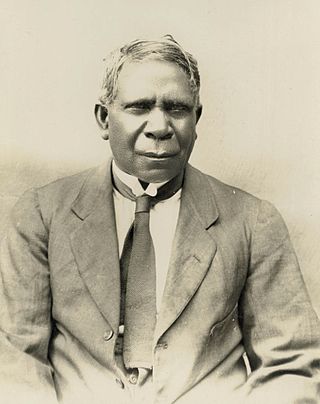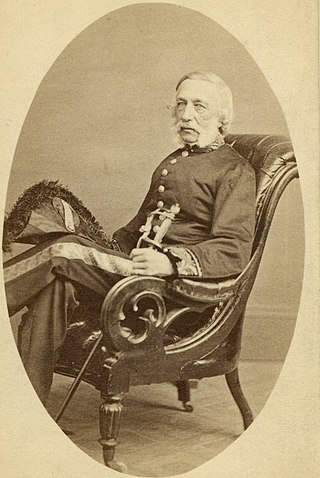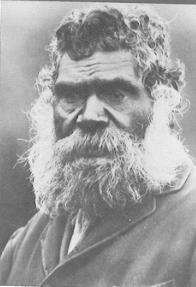
David Ngunaitponi, known as David Unaipon, was an Aboriginal Australian preacher, inventor, and author. A Ngarrindjeri man, his contribution to Australian society helped to break many stereotypes of Aboriginal people, and he is featured on the Australian $50 note in commemoration of his work. He was the son of preacher and writer James Unaipon.

The Ngarrindjeri people are the traditional Aboriginal Australian people of the lower Murray River, eastern Fleurieu Peninsula, and the Coorong of the southern-central area of the state of South Australia. The term Ngarrindjeri means "belonging to men", and refers to a "tribal constellation". The Ngarrindjeri actually comprised several distinct if closely related tribal groups, including the Jarildekald, Tanganekald, Meintangk and Ramindjeri, who began to form a unified cultural bloc after remnants of each separate community congregated at Raukkan, South Australia.
Awabakallanguage is an Australian Aboriginal language that was spoken around Lake Macquarie and Newcastle in New South Wales. The name is derived from Awaba, which was the native name of the lake. It was spoken by Awabakal and Wonnarua peoples.
The Australian colonies and in the nineteenth century created offices involved in dealing with indigenous people in the jurisdictions.

James Unaipon, born James Ngunaitponi, was an Australian Indigenous preacher of the Warrawaldie Lakalinyeri of the Ngarrindjeri.
Ngarrindjeri, also written Narrinyeri, Ngarinyeri and other variants, is the language of the Ngarrindjeri and related peoples of southern South Australia. Five dialects have been distinguished by a 2002 study: Warki, Tanganekald, Ramindjeri, Portaulun and Yaraldi.

William Wyatt was an early settler and philanthropist in South Australia. He was the third interim Protector of Aborigines in the colony between 1837 and 1839, worked on documenting the Kaurna language of the local Australian Aboriginal inhabitants of Adelaide and was a member of many boards, involved with fields as diverse as education, medicine and horticulture.

William Ramsay Smith, frequently referred to as Ramsay Smith, was a Scottish physician, educator, naturalist, anthropologist and civil servant, who worked in South Australia after moving there at the age of about 37 in 1896. He was initially appointed as a pathologist at the Royal Adelaide Hospital and was later appointed to other roles, including that of city coroner in Adelaide, but his legacy has been marred by allegations of misuse of human remains. He made a study of Aboriginal Australians, and sent body parts to Edinburgh University's anthropological collection. He published a number of books and articles in scientific journals, and in 1930 published a work under his own name which was later found to be the work of Ngarrindjeri Elder David Unaipon.
Charles Duguid was a Scottish-born medical practitioner, social reformer, Presbyterian lay leader and Aboriginal rights campaigner who lived in Adelaide, South Australia for most of his adult life, and recorded his experience working among the Aboriginal Australians in a number of books. He founded the Ernabella mission station in the far north of South Australia. The Pitjantjatjara people gave him the honorific Tjilpi, meaning "respected old man". He and his wife Phyllis Duguid, also an Aboriginal rights campaigner as well as women's rights activist, led much of the work on improving the lives of Aboriginal people in South Australia in the mid-twentieth century.
Point Pearce, also spelt Point Pierce in the past, is a town in the Australian state of South Australia. The town is located in the Yorke Peninsula Council local government area, 194 kilometres (121 mi) north-west of the state capital, Adelaide.

Poltpalingada Booboorowie was a prominent Aboriginal man of the Thooree clan of the Ngarrindjeri nation, who lived among the community of fringe dwellers in Adelaide, South Australia during the 1890s. He was a well-known and popular figure among Adelaide residents, who knew him as Tommy Walker, and his antics and court appearances were reported upon regularly in the newspapers.
George Taplin was a Congregationalist minister who worked in Aboriginal missions in South Australia, and gained a reputation as an anthropologist as well, writing on Ngarrindjeri lore and customs.

Raukkan is an Australian Aboriginal community situated on the south-eastern shore of Lake Alexandrina in the locality of Narrung, 80 kilometres (50 mi) southeast of the centre of South Australia's capital, Adelaide. Raukkan is "regarded as the home and heartland of Ngarrindjeri country."
The Aboriginal South Australians are the Indigenous people who lived in South Australia prior to the British colonisation of South Australia, and their descendants and their ancestors. There are difficulties in identifying the names, territorial boundaries, and language groups of the Aboriginal peoples of South Australia, including poor record-keeping and deliberate obfuscation, so only a rough approximation can be given here.
The Erawirung people, also known as Yirau, Juju and other names, were an Aboriginal Australian people whose traditional territory was located in what is today the Riverland of South Australia. They consisted of sub-groups or clans, including Jeraruk, Rankbirit and Wilu, and have been referred to as Meru people, which was a larger grouping which could also include the Ngawait and Ngaiawang peoples.
Francis William Cox was the first pastor of the Hindmarsh Square Congregational church in Hindmarsh Square, Adelaide, South Australia.
The Jarildekald people, also known as Yarilde or Yaralde, are an Aboriginal Australian people of South Australia originating on the eastern side of Lake Alexandrina and the Murray River.

The Arabana, also known as the Ngarabana, are an Aboriginal Australian people of South Australia.
The Antakirinja, otherwise spelt Antakarinya, and alternatively spoken of as the Ngonde, are an indigenous Australian people of South Australia.

Ivaritji also spelt Iparrityi and other variations, and also known as Amelia Taylor and Amelia Savage, was an elder of the Kaurna tribe of Aboriginal Australians from the Adelaide Plains in South Australia. She was "almost certainly the last person of full Kaurna ancestry", and the last known speaker of the Kaurna language before its revival in the 1990s.









